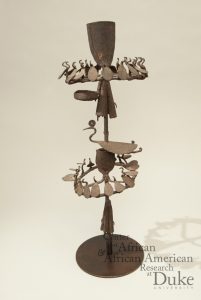There is more than what meets the eye; an old saying that resonated through my head as I paid my first visit to the “Spirited Things” exhibit at the University of Vermont’s Fleming Museum. This exhibit features sacred artifacts sourced from ancient West African religion as well as the diasporic communities that resulted from the displacement of African peoples as early as the 16th century. Pacing the Museum space, my eyes quickly shifted from object to object searching for popping hues and intricacy. Turning the corner to view the second half of the museum space, I spotted one particular encased object that stood alone.
Labeled “Staff of Fate” (Opa Osun), this artifact seemed to have a gravitating affect due to its isolated position in the context of the museum. Approaching the object, I realized that it contained many rusted limbs hinting at its archaic age. Reading the provided information for the staff I learned that it was composed of chiefly iron. The object appeared to have levels near the top and bottom that resembled disks. On the outer rim of these disks lie many small iron sculpted birds that face the stalk of the staff. Between both of these disks, a larger adorned bird is presented to face outwards. The very top of the staff contains a conical shape that is attached to a tray that leads down below the upper-disc. Adjacent to the tray lies 4 narrow rusted bells that are fastened to the object, and this is symmetrically represented below the lower-disc as well.
The object as a whole relays a sense of authoritative commandment to the viewer, and I began to think whether or not the artifact remained this way in an exhibition environment that lacked originality. In this essay, I will explore if the Opa Osun staff is interpreted as an object that retains the same rules and guidelines of handling it in the museum surroundings. By determining this I hope to explain the significance of such an artifact in present day culture.
Western Africa is home to ancient Yorubaland, a civilization where kingdoms once flourished in a framework of revolutionary urbanization (Okediji 1997). Within these kingdoms, artistic representations of sculpture containing highly refined naturalistic elements prospered and became a vital part of the religious traditions of the Yoruba (Drewal, Pemberton, & Abiodun 1989). Craftsmen became highly skilled in the creation of sculpture using metals such as copper, brass, and bronze as well during this time. The Opa Osun Staff is an example of the refined craftsmanship that characterizes the artistic creations of Yoruba people. A time that can be considered a period of enlightenment in West Africa ended with the 18th and 19th century slave trade dispersal, resulting in various diaspora in the New World. Forcefully relocated to a foreign frontier, Yoruba traditionalists brought the religious devotion that was engraved in their culture and implemented its practices to garner strength against the harsh regiment of their new lives. One aspect of culture that is particularly vital to devotion is the concept of ase. In terms of the cultural ideas that made their way from the heart of Yorubaland to the New World, ase is the most important phenomenon that survived the transatlantic journey (Abiodun 2014). The Yoruba understand ase to be a force of power in all living and nonliving things. Religious objects found in the “Spirited Things” exhibit, inhabit the concept of ase, which solidifies an entity’s connection to the higher power orisa, or spiritual divinities, in turn giving the object purpose (Abiodun 2014).
Staffs similar to the Opa Osun are ase potent tools used by priests in Yoruba culture for many different ceremonies and initiations (Abiodun 2014). One purpose of an iron staff is to establish the presence of ase in the context of religious ceremony, wielded vertically in the right hand of a priest (Abiodun 2014). The role of these staffs in ceremonial context, particularly the orientation of the staffs in a priest’s hand, offers insight to the question posited. This leads to the explanation of the specific Opa Osun Staff as an embodiment of a particular owner. Being that the staff is related to the fate of those who associate with it, it must never be placed in a horizontal manner, as this act would bring tremendous ill-will to those associated (Duke University 2015??). This fact accounts for the vertical orientation in the hands of a priest.
Staffs similar to the Opa Osun are also used to satisfy spiritual bodies known as orisa in Yoruba culture. In one particular case, a staff is used as a sacrificial stand for the placement of animal parts. In a ceremony known as Itefa, an official will dismember a cock and place the individual parts of its body on the staff as an offering to the orisa Osun (Drewal and Thompson 1989). The role of a staff similar to the Opa Osun in this fashion further attests the stark power of such an object. Whether or not this object preserves the power it has for the duration of its standing is in question still. ———————————————————————————–

Bibliography
Abiodun, Rowland. Yoruba Art and Language: Seeking the African in African Art. Cambridge:
Cambridge University Press, 2014. doi:10.1017/CBO9781107239074.
Drewal, Margaret Thompson, and Henry John Drewal. “An Ifa Diviner’s Shrine in
Ijebuland.” African Arts 16, no. 2 (1983): 61-100. doi:10.2307/3335852.
Drewal, Henry John & Pemberton, John, 1928- & Abiodun, Rowland & Wardwell, Allen
(1989). Yoruba : nine centuries of African art and thought. Center for African Art in
association with H.N. Abrams, New York
Okediji, Moyo. “Art of the Yoruba.” Art Institute of Chicago Museum Studies 23, no. 2 (1997):
165-98. doi:10.2307/4104382.
“Opa Osun, D027.” The Sacred Arts of the Black Atlantic. Accessed October 30, 2017.
http://sacredart.caaar.duke.edu/.
Opa Osun. 2015. The Sacred Arts of the Black Atlantic, Duke University, Durham.
Thompson, Robert Farris. Face of the gods: the artists and their altars. 1st ed. Vol. 28. Museum
for African Art, 1993.
Jamie Bottino